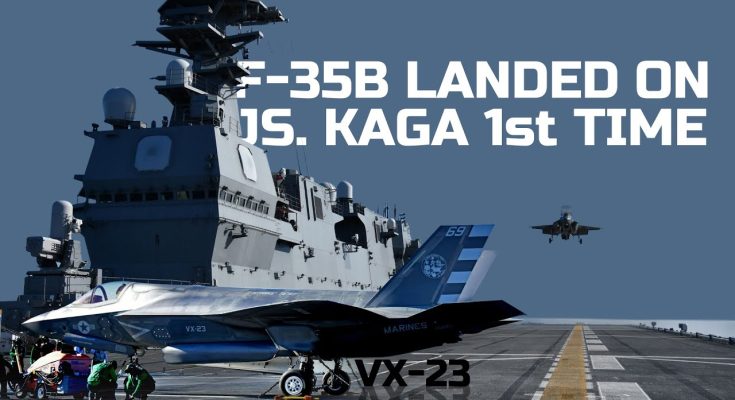Japan’s Two New Aircraft Carriers Ready to Receive the F-35B Super Fighter Jet
Japan is set to enhance its maritime defense capabilities with the integration of two new aircraft carriers, the Izumo and Kaga, into its fleet. These carriers are now being equipped to operate the highly advanced F-35B Lightning II, a fifth-generation stealth fighter designed for short takeoff and vertical landing (STOVL). This strategic move marks a significant shift in Japan’s military policy, reinforcing its maritime security and providing a powerful deterrent in the Pacific region.
The New Aircraft Carriers: The Izumo and Kaga
The Japanese Maritime Self-Defense Force (JMSDF) originally commissioned the Izumo and Kaga in 2015 and 2017, respectively, as helicopter destroyers. They were primarily designed to deploy and operate helicopters, enhancing Japan’s capabilities for anti-submarine warfare, disaster response, and humanitarian missions. However, with increasing security concerns in the Pacific, especially from China’s growing naval power, Japan has taken steps to adapt these ships to operate advanced fixed-wing aircraft, particularly the F-35B.
Both ships are large, flat-decked vessels, making them suitable for the modification needed to operate the F-35B, which requires a short runway or the ability to land vertically. The modifications include reinforcing the flight deck, installing advanced aviation facilities, and ensuring the ships’ infrastructure can support the maintenance and operations of the F-35Bs.
The F-35B: A Game Changer for Japan’s Defense
The F-35B is a variant of the F-35 Lightning II, designed to perform short takeoffs and vertical landings. This capability allows the F-35B to operate from smaller, less capable airstrips, or in Japan’s case, from ships like the Izumo and Kaga, which traditionally were not designed for fixed-wing aircraft operations.
What sets the F-35B apart from traditional fighter jets is its advanced stealth technology, superior avionics, and exceptional maneuverability. The aircraft features cutting-edge radar-evading capabilities, making it nearly invisible to enemy detection systems. Its onboard sensors provide comprehensive situational awareness, allowing pilots to detect, identify, and engage targets at long ranges. The combination of stealth, versatility, and high performance makes the F-35B an invaluable asset for Japan, especially as tensions rise in the Indo-Pacific region.
Strategic Importance of the F-35B and Japan’s New Carriers
Japan’s decision to operate the F-35B on its new carriers signals a major shift in the country’s defense posture. The acquisition of these advanced aircraft carriers and the deployment of F-35Bs is not just about enhancing Japan’s military capabilities, but also asserting its role as a key player in regional security. By operating these carriers, Japan can project air power over a vast area, including the East China Sea, the South China Sea, and even the Pacific Ocean.
The F-35Bs on these carriers give Japan the ability to respond rapidly to threats, whether they come from air, sea, or land. They can be used for a range of operations, including surveillance, reconnaissance, air superiority missions, and strike operations. Furthermore, the F-35Bs significantly enhance Japan’s ability to engage in joint operations with allied nations, particularly the United States, which operates its own fleet of F-35s.
The carriers also improve Japan’s capabilities in humanitarian and disaster relief missions, as the F-35Bs can quickly deploy in areas where traditional land-based aircraft would struggle to operate. This flexibility is crucial in a region prone to natural disasters, where Japan’s humanitarian assistance is often vital.
Concerns and Challenges
While the deployment of these carriers and the F-35B fighter jets is seen as a positive step for Japan’s defense, it has raised concerns in some quarters. China, in particular, views Japan’s growing military capabilities with apprehension. Beijing’s military buildup and territorial claims in the South China Sea have made Japan more cautious and defensive in its approach to regional security. The new carriers and F-35Bs could be interpreted as a direct counter to China’s expanding naval power.
Domestically, some critics within Japan have expressed concerns about the potential escalation of military tensions. Japan’s pacifist constitution, which limits its military actions to self-defense, has long been a topic of debate. The move to operate aircraft carriers and stealth fighter jets, while legal under Japan’s current defense framework, may provoke further debate within the country about the role of its Self-Defense Forces.
Conclusion
Japan’s Izumo and Kaga aircraft carriers, now ready to deploy the F-35B Lightning II, represent a major step forward in the country’s defense strategy. The integration of these advanced assets into the Japanese Self-Defense Forces allows the nation to project power and secure its interests in an increasingly volatile region. While concerns exist, especially regarding China’s response, Japan’s commitment to enhancing its maritime defense capabilities with cutting-edge technology will undoubtedly strengthen its role as a key player in Indo-Pacific security. With the F-35B, Japan is poised to face emerging threats head-on, while also reinforcing its commitment to peace and stability in the region.



